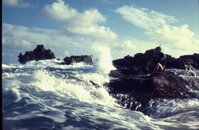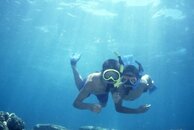I read some time ago about surface drowning. If a person aspirates sea water somehow it messes the lungs ability to process 02. I don't remember my biology well enough to articulate the condition. Hopefully some of our medical experts can chime in. The "drowning" may occur hours after aspirating the salt water. One of the cases I read about involved a child and the doctor was totally confused as the cause of death was drowning but the kid died in his bed.
You are using an out of date browser. It may not display this or other websites correctly.
You should upgrade or use an alternative browser.
You should upgrade or use an alternative browser.
Drowning on the surface
- Thread starter Storker
- Start date
Please register or login
Welcome to ScubaBoard, the world's largest scuba diving community. Registration is not required to read the forums, but we encourage you to join. Joining has its benefits and enables you to participate in the discussions.
Benefits of registering include
- Ability to post and comment on topics and discussions.
- A Free photo gallery to share your dive photos with the world.
- You can make this box go away
I read some time ago about surface drowning. If a person aspirates sea water somehow it messes the lungs ability to process 02. I don't remember my biology well enough to articulate the condition. Hopefully some of our medical experts can chime in. The "drowning" may occur hours after aspirating the salt water. One of the cases I read about involved a child and the doctor was totally confused as the cause of death was drowning but the kid died in his bed.
I believe this is similar to what happens with pneumonia. The fluid in lungs disrupts some layer on the lungs/alveoli that helps/enables the oxygen transfer. The details are in one of my training books.
I think the above is more or less right, but someone else can probably give you a better answer.
It can be unnerving to be on the surface in heavy chop. I don't think a snorkel makes things much better, since the water will break over the snorkel, too, if the chop is rough.
It does, actually, make a big difference to your comfort in heavy chop. It's the one use for a snorkel while diving that actually makes sense to me.
R..
I believe this is similar to what happens with pneumonia. The fluid in lungs disrupts some layer on the lungs/alveoli that helps/enables the oxygen transfer. The details are in one of my training books.
I think the above is more or less right, but someone else can probably give you a better answer.
When I stared diving, the term "dry" drowning was used. It could happen on the surface or underwater if you inhaled a small amount of water and triggered an immediate laryngeal spasm. If it didn't relax in time you pass out and death would occur. I thought the pulmonary edema process was a delayed response, although the episode could have started at depth. Whatever, it was unfortunate accident. Cheers
An overweighted diver and a too-large BCD is a really bad combination at the surface. Throw in a leg cramp and that person may easily drown mere inches from all the air in the world.
All divers are taught to ditch weights in an emergency. 90% of all diver deaths were recovered with the weight still on. It may sound harsh, but the ocean is an entity completely without mercy. I tell my students that the lead they are carrying is indeed 'dead weight'.
All divers are taught to ditch weights in an emergency. 90% of all diver deaths were recovered with the weight still on. It may sound harsh, but the ocean is an entity completely without mercy. I tell my students that the lead they are carrying is indeed 'dead weight'.
AfterDark
Contributor
deleted
- Messages
- 2,734
- Reaction score
- 752
- # of dives
- 500 - 999
I've had a couple of shore diving incidents that scared the bejeezus out of my husband because while it was happening he didn't know I had a regulator in my mouth. Once, I was stuck in a surf, maybe 12 inches of water and kept getting turtles but couldn't get my head up because waves kept pounding me back down.
The other time, I was trying to get through the surf zone and I couldn't get a strong enough kick to get through the waves.
Both times, I knew to keep the regulator in my mouth as I had been taught, but of course, when a lived one is in trouble, you think the worst things. As it was happening to me, I was entirely calm both times, because I had air and could breathe. I simply couldn't get enough control to get out of the pounding waves or surf that I was trapped in.
Keep your regulator in your mouth on the surface unless you're in the swimming pool or a calm lake! Someday, it might save your life. It's a very good habit to get into. While exiting from the water onto a boat or the shore especially, keep the regulator in. Until you are safely in. That means several feet up the stairs or well into the dry zone.
The other time, I was trying to get through the surf zone and I couldn't get a strong enough kick to get through the waves.
Both times, I knew to keep the regulator in my mouth as I had been taught, but of course, when a lived one is in trouble, you think the worst things. As it was happening to me, I was entirely calm both times, because I had air and could breathe. I simply couldn't get enough control to get out of the pounding waves or surf that I was trapped in.
Keep your regulator in your mouth on the surface unless you're in the swimming pool or a calm lake! Someday, it might save your life. It's a very good habit to get into. While exiting from the water onto a boat or the shore especially, keep the regulator in. Until you are safely in. That means several feet up the stairs or well into the dry zone.
I read some time ago about surface drowning. If a person aspirates sea water somehow it messes the lungs ability to process 02. I don't remember my biology well enough to articulate the condition. Hopefully some of our medical experts can chime in. The "drowning" may occur hours after aspirating the salt water. One of the cases I read about involved a child and the doctor was totally confused as the cause of death was drowning but the kid died in his bed.
It's covered pretty well in Chapter 9 of The Complete Diver: The History, Science and Practice of Scuba Diving: Alex Brylske Ph.D.: 9780615721330: Amazon.com: Books . If you haven't read this book, I found it very educational.
In the U.S. Navy School for Underwater Swimmers, we were taught to keep our masks on and our mouthpiece in our mouth until completing an exit. If we had our mask on our forehead, the instructor would yell, "Who do you think you are, Mike Nelson? Drop for twenty!" pushups, that is. Those pushups were with our tanks (those twin 90s) on our backs too. Needless to say, we learned not to drop our mouthpiece or put our masks on our foreheads so that they could be knocked off by a wave. But sometimes it takes a dramatic event to make the point too.
Concerning getting positively buoyant on the surface, there are two things to say about this. First, I was first taught by the my LA County scuba instructor, Roy France in 1963 that at the beginning of a dive, we should be pretty much neutrally buoyant at the surface. He defined this as floating at eye level on a full breath without any buoyancy aid. That way, we could exhale and descend easily. Also, at the end of the dive, with this weighting we would be slightly positively buoyant on the surface. This was before we had buoyancy compensators.
The second thing about buoyancy and being positively buoyant on the surface is that this may not be enough. Many current buoyancy compensators do not support a diver from the front or under the arms, and therefore when inflated will tend to push the diver onto his or her face. The buoyancy compensator is not meant many times to be a surface floatation device, but to compensate for the loss of buoyancy of the wet suit as a diver descends. Therefore, the current back-mounted BCs area trying to achieve neutral buoyancy at depth in a prone, face-down position. On the surface, you need to lean back to get these devices to support you head-up. This is a different learned skill, and should be practiced with the BC that you are using. I designed a BC, which I call the Para-Sea BC, which would support under the arms and face-up on the surface, but it was never picked up commercially. The current designs leave something to be desired, in my opinion. We used to have a surface float, usually a tube with a diver's flag, for just such a use, but that is not being done currently.
Now, about snorkels and their use in chop. There are snorkels, and there are snorkels; some are better than others. My favorites are the Scubapro Shotgun (no longer made) and the U.S. Divers Company Impulse snorkel (see the photo below of my boys in Hawaii using the Impulse snorkel in about 1986). It uses the principal of capillary action to have the water entering the snorkel travel down the bell, then out a non-return valve in the bell. The inhalation tube extends into the bell and remains pretty dry except in overwhelming wave action. I have not used the current version, the Impulse 3, but if it is the same principal as the first version, it should do well in chop. I have the newer Scubapro Shotgun snorkel, but I don't think it is quite as good as the original, and its mouthpiece doesn't fit my mouth. I also have the TUSA HyperDry, and do not like it, as it is not completely dry, and it's mechanism for restricting wave action down the tube also restricts breathing. Be that as it may, any snorkel is better than none, and one must learn how to use these in chop or wave situations. The old, J-tube snorkels actually functioned quite well by simply blast-clearing them. I used the Scubapro Shotgun snorkel, which I cut off at the top of my head, on an 18-mile open water fin swim in the 1980s, and it functioned quite well even in chop and with the top part cut down (to lessen dead space for the marathon swim).
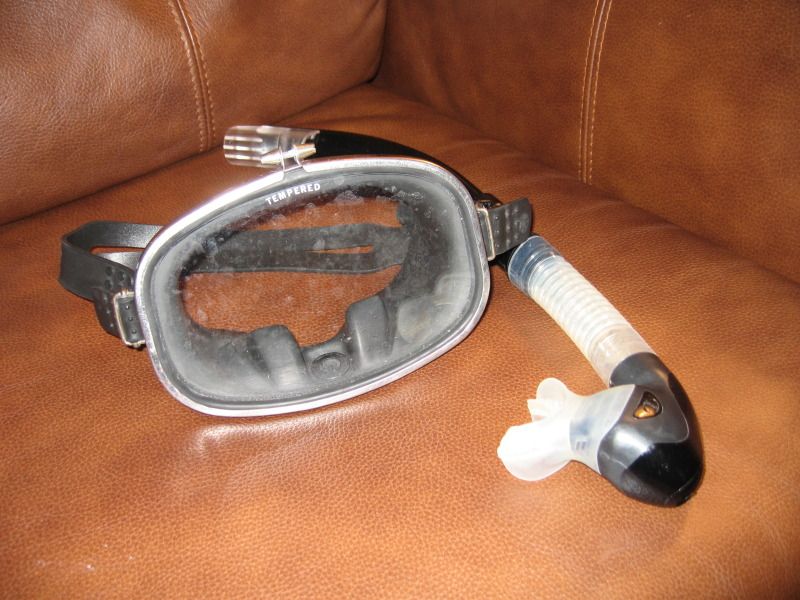
HyperDry Snorkel
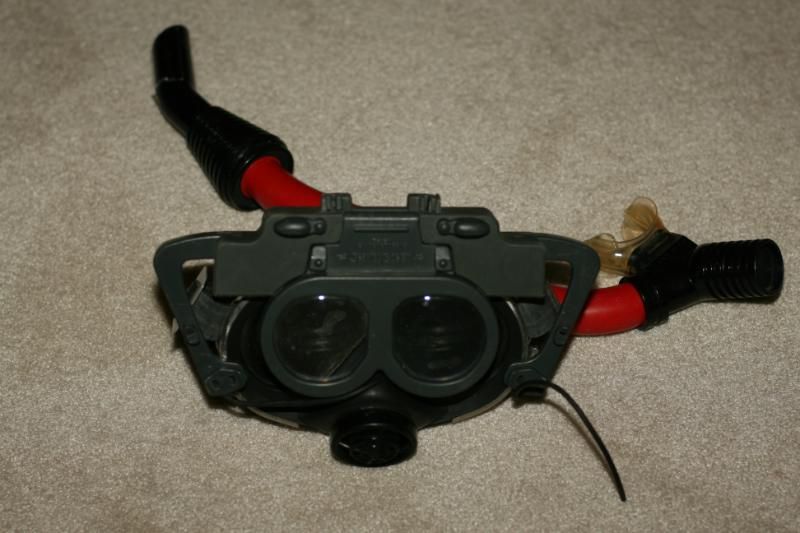
Impulse Snorkel
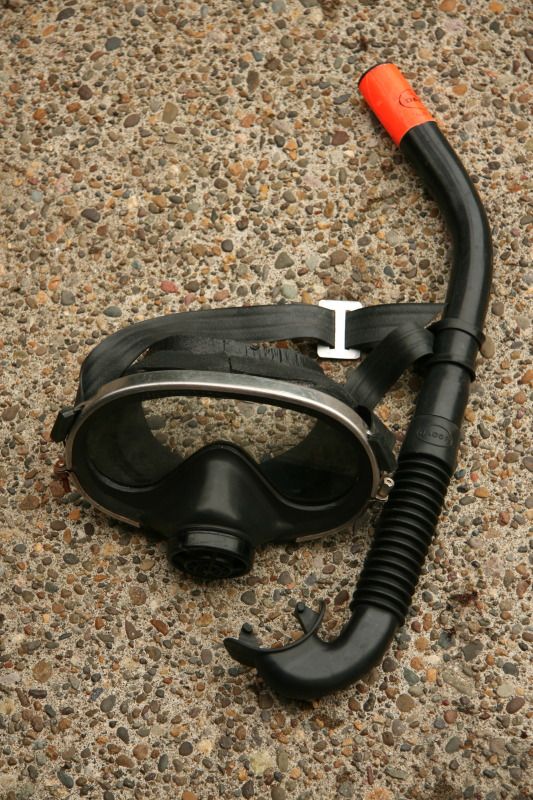
Older-style Dacor Snorkel--this had a smooth tube inside, and functioned very well, but needed to be blown clean if a wave came over it.
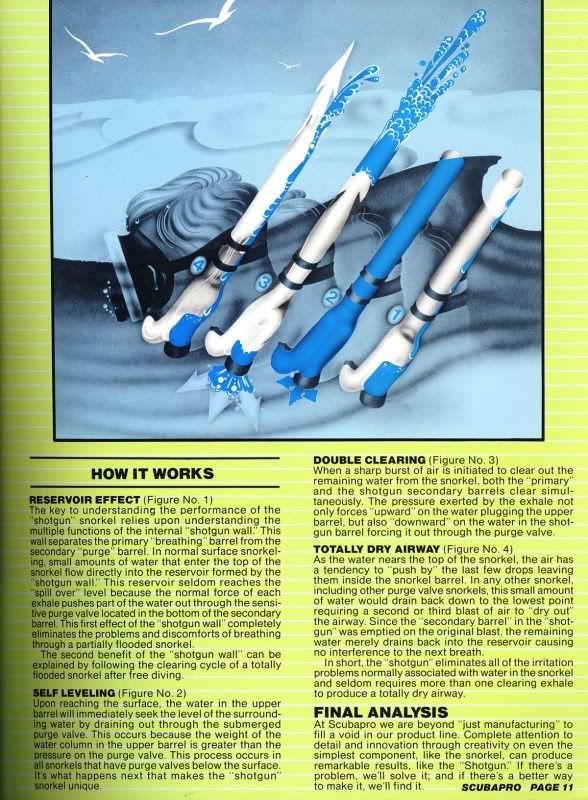
Theory behind the Scubapro Shotgun snorkel, from their 1980s catalog.
When I dive, even in the river where there is no chop, I continue to keep the mouthpiece or snorkel in my mouth until I have effectively exited. Not only do they provide air if I slip and go back into the water without my fins (I sometimes do a bit of rock climbing to exit), but if I should fall on my face they will provide some cushion to my teeth.
SeaRat
Concerning getting positively buoyant on the surface, there are two things to say about this. First, I was first taught by the my LA County scuba instructor, Roy France in 1963 that at the beginning of a dive, we should be pretty much neutrally buoyant at the surface. He defined this as floating at eye level on a full breath without any buoyancy aid. That way, we could exhale and descend easily. Also, at the end of the dive, with this weighting we would be slightly positively buoyant on the surface. This was before we had buoyancy compensators.
The second thing about buoyancy and being positively buoyant on the surface is that this may not be enough. Many current buoyancy compensators do not support a diver from the front or under the arms, and therefore when inflated will tend to push the diver onto his or her face. The buoyancy compensator is not meant many times to be a surface floatation device, but to compensate for the loss of buoyancy of the wet suit as a diver descends. Therefore, the current back-mounted BCs area trying to achieve neutral buoyancy at depth in a prone, face-down position. On the surface, you need to lean back to get these devices to support you head-up. This is a different learned skill, and should be practiced with the BC that you are using. I designed a BC, which I call the Para-Sea BC, which would support under the arms and face-up on the surface, but it was never picked up commercially. The current designs leave something to be desired, in my opinion. We used to have a surface float, usually a tube with a diver's flag, for just such a use, but that is not being done currently.
Now, about snorkels and their use in chop. There are snorkels, and there are snorkels; some are better than others. My favorites are the Scubapro Shotgun (no longer made) and the U.S. Divers Company Impulse snorkel (see the photo below of my boys in Hawaii using the Impulse snorkel in about 1986). It uses the principal of capillary action to have the water entering the snorkel travel down the bell, then out a non-return valve in the bell. The inhalation tube extends into the bell and remains pretty dry except in overwhelming wave action. I have not used the current version, the Impulse 3, but if it is the same principal as the first version, it should do well in chop. I have the newer Scubapro Shotgun snorkel, but I don't think it is quite as good as the original, and its mouthpiece doesn't fit my mouth. I also have the TUSA HyperDry, and do not like it, as it is not completely dry, and it's mechanism for restricting wave action down the tube also restricts breathing. Be that as it may, any snorkel is better than none, and one must learn how to use these in chop or wave situations. The old, J-tube snorkels actually functioned quite well by simply blast-clearing them. I used the Scubapro Shotgun snorkel, which I cut off at the top of my head, on an 18-mile open water fin swim in the 1980s, and it functioned quite well even in chop and with the top part cut down (to lessen dead space for the marathon swim).

HyperDry Snorkel

Impulse Snorkel

Older-style Dacor Snorkel--this had a smooth tube inside, and functioned very well, but needed to be blown clean if a wave came over it.

Theory behind the Scubapro Shotgun snorkel, from their 1980s catalog.
When I dive, even in the river where there is no chop, I continue to keep the mouthpiece or snorkel in my mouth until I have effectively exited. Not only do they provide air if I slip and go back into the water without my fins (I sometimes do a bit of rock climbing to exit), but if I should fall on my face they will provide some cushion to my teeth.
SeaRat
Attachments
Last edited:
PeterNBiddle
Contributor
I inflate my BC manually at the surface after every dive. I do this because of the stories I've heard about post-dive drownings and sinkings (many of which seem to include OOA scenarios). I don't want to be reliant on tank air to inflate.
Similar threads
- Replies
- 0
- Views
- 227
- Replies
- 0
- Views
- 849
- Replies
- 0
- Views
- 1,034
- Replies
- 23
- Views
- 3,672
- Replies
- 0
- Views
- 570




